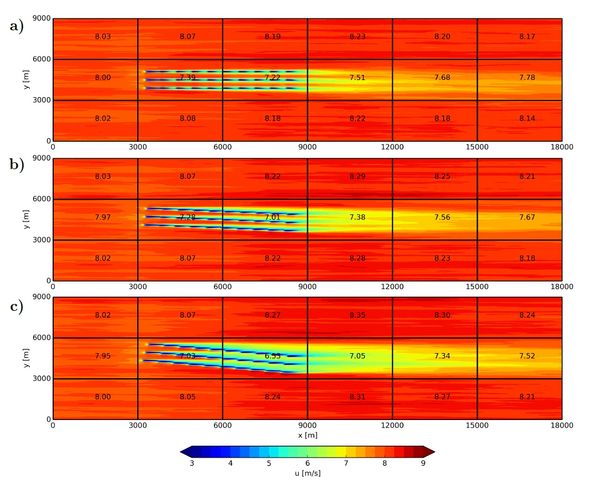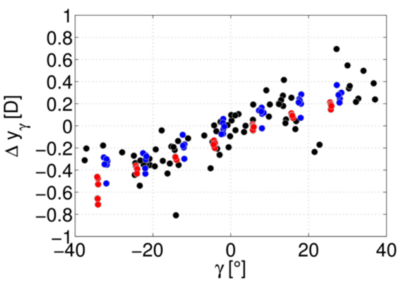Flow modelling in wind farms
Contact
Dr. Gerald Steinfeld
Carl von Ossietzky Universität Oldenburg
Institut für Physik
AG Energiemeteorologie
Tel: +49 441 798-5073
E-Mail: gerald.steinfeld@uni-oldenburg.de
Flow modelling in wind farms
Simulation of flow conditions in wind farms
Wind turbines operate in the atmospheric boundary layer, i.e. in the layer of the atmosphere immediately above the ground, in which the flow is characterised by friction at the ground and the heating of air masses near the ground by turbulence. Wind turbines extract part of their kinetic energy from the atmospheric flow and convert it first into mechanical and then into electrical power. Accordingly, the flow downstream of a wind turbine (in the so-called wake area) is characterised by a reduced wind speed compared to the background flow. Due to the lower speed and the production of turbulence by shear in the transition area between the wake area and the undisturbed flow, the flow in the wake area is simultaneously characterized by an increased turbulence intensity. The properties of the wake flow, such as the recovery of the velocity deficit, depend strongly on the properties of the atmospheric boundary layer upstream of the wind turbine.

For wind farm planning, e.g. to avoid shading of wind turbines by upstream wind turbines as far as possible, the most precise information possible on the expected flow conditions is required.
Since, as shown above, the flow in wind farms is characterized by turbulent processes, turbulence-resolving models are required for the most accurate representation of the wind farm flow in the numerical simulation.
At ForWind, the turbulence-resolving, atmospheric coarse structure simulation model PALM developed at Leibniz Universität Hannover is used for the most precise simulation of the wind farm flow.
In recent years, ForWind at the University of Oldenburg has implemented various methods for the consideration of wind turbines in PALM.
The simplest approach is a so-called actuator disk model (ADM), in which the wind turbines are represented simply by disks with uniform thrust. For applications where the flow at some distance behind the wind turbine is crucial, this modeling approach is already sufficient.
In the actuator line model (ALM) the rotor blades are represented in a simplified way by rotating lines, which are divided into several segments. For each segment lift and flow resistance are then calculated using the blade element method. This approach is also recommended for very detailed investigations of the flow directly downstream of the simulated wind turbine.
Based on the actuator line model a coupling of PALM with the aeroelastic code PALM has been developed at ForWind during the last years. This coupling allows a detailed analysis of the loads on wind turbines under different turbulent inflow conditions.
The turbine model most frequently used at ForWind and meanwhile included in the standard PALM code is the actuator disk model with rotation. This model is very similar to the actuator line model and therefore rotation effects are also considered in it. However, since it does not contain moving rotor lines, it can be used with a comparatively large time step. Therefore it requires much less computing power than the actuator line model.
A current field of application of wind farm simulations with PALM at ForWind is the derivation of wind farm parameterizations for larger-scale atmospheric simulation models, such as weather forecast models. For example, this involves improved consideration of shadowing effects within the wind farm when calculating the wind farm effect. Figure 1 shows, for example, that the velocity deficit behind a wind farm is strongly dependent on the wind direction under which the wind farm is exposed to the wind.
Another example is the use as a numerical test environment for the development of procedures for the control of wind farms. In investigations with PALM it could be shown that a deliberate misalignment of a wind turbine to the wind can be used to deflect the wake. This means that wake runs can be directed past following wind turbines. Further investigations with PALM then showed that the atmospheric stratification is a decisive input variable for the deflection of the wake (see Figure 2).

Mit Hilfe der numerischen Testumgebung soll im aktuellen Projekt CompactWind II ein möglichst einfaches Sensorkonzept zur Bestimmung der für die Nachlaufregelung erforderlichen atmosphärischen Parameter entwickelt werden.


